Winifred L. Mitchell and
Paul F. Brown are Professors in the Department
of Anthropology, Minnesota State University,
Mankato, Minnesota, United States.
Can the subsistence patterns, social organization and ideology of traditional mountain cultures persevere in the modern world? The example of the Aymara people of the Peruvian Andes.
Five hundred kinds of flowers of as many kinds of potatoes grow... in the earth; mixed with night and gold, silver and day.
The hundred flowers of quinoa which I planted at the summit bubble their colors in the Sun; the black wings of the condor and of the tiny birds are now in flower.
It is noon; I am close to the lord-mountains, the ancestor peaks; their snow now yellow flecked, now with red patches, is shining in the Sun ...
... look at my face, my veins; the winds blowing from us to you, we all breathe them; the earth on which you count your books, your machines, your flowers, it comes down from mine, improved, no longer angry, a tamed earth ...
We don't know what will happen. Let death walk towards us, let these unknown people come.
We will await them; we are the sons of the father of all the lord-mountains; sons of the father of all the rivers.
José María Arguedas
from "A call to some doctors", 1966
(translated from Quechua)
With his 1966 poem "A call to some doctors" (that is, scientists), the Peruvian writer José María Arguedas decried the dominant lowlands' imposition of judge-ment and changes on the indigenous Andean way of life (Murra, 1986). The lines above are a reminder that however well intentioned, lowlanders observing mountain people and their cultures are intruders, imposing flatland categories on an ancient bastion of tradition in balance with an awesome landscape.
About 26 percent of the world's population lives in or near mountains (Meybeck, Green and Vörösmarty, 2001), with only 2 percent being residents of the highest mountain chains (Grôtzbach and Stadel, 1997). The peasant inhabitants of high mountain regions, like their counterparts at lower elevations, live in a world of fields, grazing lands and forests which provide them with their main sources of sus-tenance. They are far from the political centres of their nations, not just geographically but in terms of their political participation and influence. Many share the disadvantages of rural poverty and ethnic or religious discri-mination. Mountain peoples, however, face additional challenges to subsistence brought about by elevation, rough topography and severe climate. Even natural disasters such as earthquakes, landslides, avalanches and floods are more likely to occur in mountain areas (Ives, 1997). Highland communities have developed cultural strategies over the centuries to sustain life in their often fragile and unforgiving environments.
This article focuses mainly on one group of mountain people, the Aymara of the Peruvian Andes. Their culture fits into Grôtzbach and Stadel's (1997) category of mountain peasants living in old and relatively densely settled high mountains and practising largely intact traditional subsistence patterns. In this sense, they may represent a "typical" mountain culture, but the authors' intent is to deal with specific cultural pheno-mena rather than generalizing about the large diverse group of mountain dwellers. Some comparison is made to cultures of the mountainous regions of Central Asia, the Himalaya-Karakorum-Hindu Kush, as the two cultures share some striking cultural similarities. Both populations are small by global standards: 26 million in the Andes and 33 million in the Himalaya (Neustadtl, 1986). However, both areas have been major cultural centres and seats of ancient civilizations and remain strong pockets of cultural persistence in today's globalized world.
The traditional Aymara culture illustrates the kinds of adaptive strategy employed by mountain peoples. The Aymara are farmers and herders who inhabit the altiplano, the semi-arid basin surround-ing Lake Titicaca in the Andes of southern Peru and western Bolivia. Altiplano soils and climate combine to produce an environment in which available energy sources are limited and environmental fluctuations from year to year are severe. The altiplano lies between two massive ranges of the Andes. Its altitude ranges from 3 800 m above sea level near the lakeshore to over 4 100 m near the foothills. The soil is loose and spongy, allowing moisture to disappear rapidly from the surface. Altiplano soils have deficiencies in phosphorous, nitrogen and organic material (Winterhalder, Larsen and Thomas, 1974). The plain has been virtually treeless for centuries, a condition that is thought by some scholars to be the result of human occupation (Gade, 1999).
Highland Aymara communities consist of scattered sod houses with tin or thatch roofs separated by tiny plots of agri-cultural and pasture land. On their landholdings of 5 to 20 ha, families coax a living using labour-intensive rainfed agriculture and careful animal husbandry. They are mainly subsistence farmers, relying on the staple crops of potatoes, quinoa (Chenopodium quinoa, a small, nutritious grain that has been cultivated in the Andes for at least 5 000 years) and barley, small herds of sheep and cattle and a few pigs, chickens and the native Andean species of llama, alpaca and guinea pig. Droughts, floods, hail and frost are all possible impediments to successful farming, so families and communities must be well organized and resourceful in managing production.
Centuries of trial and error have resulted in distinctive subsistence patterns, social organization and ideology which enable highland peoples such as the Aymara and their Himalayan counterparts to thrive in their harsh mountain environments.
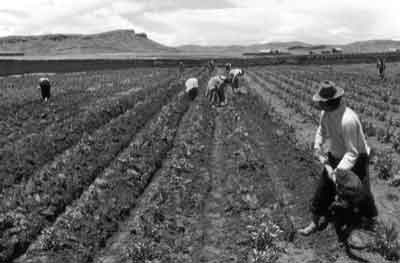
An Aymara work party uses the aporque technique to deepen downhill-sloping furrows between rows of potatoes to maximize nutrients and moisture for the plants
- P.F. BROWN
Use of multiple ecological zones. Before the Spanish conquest of Peru, the Aymara existed in a number of kingdoms or city-state clusters around the Lake Titicaca basin. In addition to their altiplano holdings, they exploited many of the coastal valleys of southern Peru, growing maize and beans (Martinez, 1961). They also kept large herds of llamas and alpacas at higher elevations where crop production was not possible. These herds served as a food bank for use during years of low agricultural yield (Murra, 1968). The exploitation of three different environments - the altiplano, the highlands and the coast - prevented food shortages in the event of ecological disaster in any one area. This adaptive process, often referred to as verticality by anthropologists (Murra, 1975) or as staggered land use by geographers, is prevalent in the traditional agricultural systems of both Asian and South American mountains (Grôtzbach and Stadel, 1997). Today, with greater population densities, communities rarely have access to land in all vertical zones, but the practice continues through human ties of trade, reciprocal relationships with family or community connections in the different ecological zones.
Dispersion of landholdings and crops. The altiplano consists of a series of micro-environments - localized, discontinuous areas marked by differences in temperature and rainfall patterns. The Aymara have achieved a partial solution to this problem with an inheritance system that fragments each family's landholdings because each child inherits some land from both parents. The Sherpas have a similar land inheritance system, although inheritance is limited to males (Ortner, 1978). This type of inheritance system results in the distribution of all land types within a community's holdings among all house-holds. Households of each community own several small parcels of land distributed among the different micro-environments. Thus, a single family may farm as many as 30 to 70 non-contiguous plots of land. In any given year a family may lose part of its crop to flooding, but if the family also owns parcels in a micro-environment that normally experiences less rainfall or has better drainage, at least part of the production will be spared. This system, resembling a micro version of verticality, includes the use of many different cultivars in each micro-environment to further reduce risk by maximizing variability. Thus Argueda's reference above to hundreds of kinds of potatoes is not a poetic exaggeration. In fact, some sources report up to 200 potato varieties planted in a single field (Richardson, 1994).
Cultivation practices. Besides distributing land over many micro-environments, the Aymara have dealt with the problems of fluctuating rainfall patterns and temperatures through a system of sloping. In preparing their fields for potatoes, still the most widely grown crop in the altiplano, the fields are ploughed along the slope of the hill rather than parallel to the contours as is the practice in most Western agriculture. The sloping method offers better drainage for the potatoes, a matter of great importance where torrential rains are always possible. In dry years the furrows help retain moisture because of the aporque technique (see below). Wild grasses growing in the furrows help to minimize erosion and to facilitate the transition to pasture land during fallow years (Orlove, 1977).
The Aymara also have a technique of modifying the potato fields which affords additional protection for the crop. After the field has been planted and the potatoes have begun to grow, the plough is passed over the furrows and the dirt is piled up around the base of each plant. This procedure, called aporque, provides a number of benefits: first, the new soil piled up around the plant adds nutrients where they are most needed; second, the plough deepens the furrow between each row of plants, ensuring proper drainage; third, in dry years the deep furrows act as tiny reservoirs, holding any available water longer than the rows do; and fourth, the water trapped by the furrows maintains a more even air temperature around the plants, protecting them against frost.
Aporque is reminiscent of the raised field technique practised by the ancient Tiwanakan Empire (200 to 1000 CE); raised field agriculture supported a city of 50 000 people (Tiwanaku) in the now rural Bolivian Titicaca Basin and an empire that stretched into present day highland Peru, Chile and Argentina (Straughan, 1991). The terrace-like system with a pattern of ridges and depressions approximately 3 to 4 m wide produced up to seven times the present altiplano yields by protecting the crops and renewing soils in a similar manner. Also used by ancient Aztec and Maya civilizations, this American technique is comparable in its labour intensivity (but perhaps superior in crop protection and soil renewal benefits) to the widespread hillside terracing seen throughout other mountain regions of the world. Terracing is also practised on the steeper slopes of Andean hills and has been from at least the time of the Incas.
Animal husbandry and collection of dung. The problems of low energy availability and poor soil quality in the altiplano and other traditional mountain agricultural zones worldwide are lessened by the careful collection of animal dung for use as fertilizer and fuel. This is supplemented by the practice of pasturing animals on fallow land, where the animals defecate and add more nutrients to the soil. Dung from cattle, donkeys, horses and camelids (both American and Asian) dries quickly in the arid climate and is easily gathered by women and children en route to pastures and fields. Dung from sheep and other similarly sized animals is left in fallow fields or high altitude grasslands to fertilize the soils. The use of lowland fodder to feed animals that will later fertilize high pastures is another example of the functional integration of different ecological zones.
Food preservation. Andean peasants must be credited with the discovery of the original freeze-drying method of preserving food. Each June, with the beginning of consistent freezing night-time temperatures, the Aymara spread small potatoes out on flat ground and let them freeze overnight. During the warm, dry days, older women and children walk around on the piles of potatoes, squeezing out the moisture. After this process has been carried out daily for two to three weeks, the potatoes are about the size of walnuts and their skin has begun to flake off. The remaining skin is then removed by scraping the potatoes back and forth across the ground with the hands repeatedly for a week or so. This process also helps to remove any moisture that still remains in the potato. The end product, called chuño, is placed in woven llama or alpaca wool bags and stored inside the house. It will keep for up to six years without spoiling. Most families try to have at least a three-year supply on hand in the event of ecological disasters that can destroy most of their potato crop. Chuño has often made the difference between survival and starvation during periods of extended drought or flood.
The yearly round of farming tasks occupies the time and energy of each family member in a mountain household. Particularly at peak times of planting, weeding, cultivating and harvest, every-one is involved. The division of labour by gender and age has much in common with practices in other cultures worldwide (Brown, 1970): women's jobs include herding, weeding, cooking, spinning and weaving, all compatible with child rearing and multitasking. Aymara women participate in most agricultural tasks but are said to be helping men.
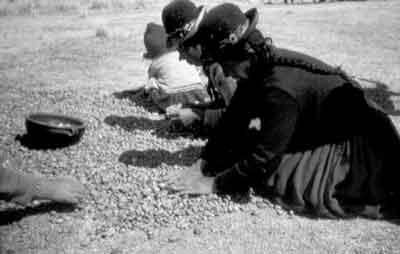
Aymara women check their chuño, potatoes preserved through freeze-drying, which keep for up to six years and can make the difference between survival and starvation during periods of drought or flood
- W.L. MITCHELL
Older adults expect to turn over more work to their middle-aged children and sons- or daughters-in-law. Men seem to retire from their labours (agricultural) more completely than do women, who continue with household jobs into their grandmother and great-grandmother years.
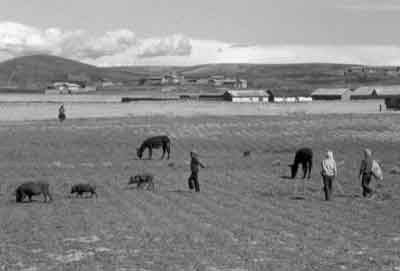
Aymara children begin at a young age to make an economic contribution to their families; herding is carried out by both boys and girls
- P.F. BROWN
Children help adults of the same gender, but girls, like their mothers, cross gender boundaries more often. For example, both boys and girls may herd sheep, haul water or tread on chuño, but boys rarely help cook. When boys of ten years or more begin to help their fathers in the men's tasks of ploughing, sowing and lifting the heavy harvest loads, they are said to be working, no longer just helping. A female of any age is always considered an agricultural helper if she works beside or in place of a man. Children begin to work at the early age of six or seven years and are seen as labour assets to the family, especially when they are not in school.
A woman who sends all her children to school will find herself burdened with so many tasks that she will probably discourage some of her children from school attendance, especially the girls. Hewitt (1997) reported a similar pattern for women of the Karakorum-Himalaya, and noted that prolonged male absences for herding or wage labour leave women behind, both physically and ideo-logically. This is also observed among the Aymara: women are less likely to be literate or fluent in Spanish, the language of the dominant culture outside the community, and as a result may be perceived by their men and by the whole nation as backward, unsophisticated and underdeveloped. Nevertheless, the household is seen as the chacha-warmi, literally the man-woman - the union of gender-prescribed efforts for the desired outcome of perpetuating family life in an uncertain world.
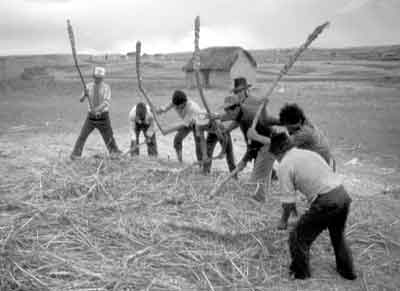
A work party of Aymara kindred threshes newly harvested quinoa (Chenopodium quinoa), a staple crop native to the Andes
- P.F. BROWN
During the agricultural off-season, male heads of household and teenagers of both genders frequently leave the Aymara villages for long periods to seek wage labour on the Peruvian coast. The cash earned from these endeavours supplements the subsistence agriculture, which can produce enough to feed most households in good years but provides no surplus for sale. Nor is there much margin, even with the ingenious chuño. The loss of a harvest or even the loss of a family member's labour through illness can erode a family's fortunes irreparably (Leatherman et al., 1986).
As is true throughout the developing world, when men migrate, women's responsibilities expand to cover the work of absent males. As Hewitt (1997) also comments for the Himalaya, women's homebound status is what enables men to migrate. Moreover, the family's continued subsistence farming acts as a subsidy which sustains the low cost of temporary wage labour in mountainous farming zones.
Temporarily absent household members often return to help out at the peak work times of the agricultural year, but the nuclear family still has insufficient labour power to complete the work within the time limits imposed by the Andean climate, and must rely on its wider kindred. Extended family members are bound by strong and enduring obligations to render assistance under an ancient Andean system of labour reciprocity known as ayni. Ayni obligates relations to render assistance to each other whenever it is needed, and those receiving assistance to return the favour during the same period in which it is received. Ayni commitments are so strong that failure to repay an ayni debt - a very rare occurrence - is considered one of the most serious offences in the countryside.
The owner of the land being worked by ayni helpers is considered the patron (the boss or overseer) of the work; he is expected to direct the activities and to set the pace. He and his wife must provide the workers with hearty meals, coca leaves and alcohol for the day. If children help, they receive sweets.
Ayni is able to function because of two environmental factors: the unequal distribution of land and other resources within the kindred, and the dispersal of landholdings over several micro-environments. Because of the unequal distribution of land and resources, those families that own more land, and thus have greater labour needs, can count on help from families that are labour rich but resource poor. In exchange, poorer families receive essential resources such as seed, tools and draught animals when they need them. Because of the dispersal of landholdings, the scheduling of work is spread out so that not all families will require additional labour at the same time. Thus, all families are assured of receiving the necessary labour input for production when they need it most.
The Sherpa mutual aid system, tsenga tsali, is remarkably similar to ayni except that the obligations endure and are passed on to succeeding generations (Ortner, 1978). Tsenga tsali bonds give produc-tion a collective aspect in spite of the Sherpa ideal of the independent nuclear family household. No doubt the fragmented land inheritance patterns that the Sherpas share with the Aymara result in the same ecological setting for reciprocal labour. Land fragmentation has sometimes been remedied by sons consolidating their lands through fraternal polyandry (all the brothers sharing one wife), a practice that continues (Goldstein, 1987) despite the fact that it has been outlawed by the Nepalese Government.
Ayni and the entire Aymara labour system are grounded in the ancient Andean notions of dualities and interdependence: of land and people; men and women; heaven and earth. The patron-for-a-day provides for his workers; obligations are strictly accounted and repaid. Men serve their communities by taking on civil-religious roles, sponsoring festivals that link people together in mutual obligations. Women and men work together to sustain their families. Even if domestic violence or a man's absence makes conditions difficult, a woman will rarely break what she sees as the necessary balance of a male-female household. This world requires a commitment to the values of balance and harmony to work well for its inhabitants. When one household or individual is at odds, everyone is potentially affected by the interconnectedness of the kindred, the genders and the generations.
The earth, too, requires balance. Mother Earth must be "paid" with offerings at harvest time and during life transitions. Ceremonies to honour her and perpetuate her bounty are held on hilltops, often at dawn, resonating with Argueda's "lord-mountains" imagery. Natural disasters are also part of the balance: a lightning strike, earthquakes, pestilence, a run of bad luck - all are attributed to an imbalance in the Andean cosmos. Lightning, for example, is a punishment from God, sent through the avenging spirit, Santiago, and directed for example at one who has not been a good, cooperative citizen (Mitchell, 1993). (Both "God" and "Santiago" are folk-Catholic blends of ancient Aymara theology and Spanish imagery.) Other catastrophes may be attributed to local evil spirits if an individual trespasses in their domains. The shamanic spiritual leaders who officiate at important ceremonies blend ancient mountain beliefs with the folk Catholicism of the past 500 years to connect the people with the spirits of the "ancestor peaks".
The Aymara are a people in transition, operating partly in the modern world of wage labour and partly in the traditional practices of ayni. In one of the communities studied by the authors in the late 1970s, only half of the households relied on ayni for agricultural labour needs. In contrast, in a more isolated, traditional community all the households used ayni (Brown, 1987). With so many men and young people absent from the less traditional community, households were looking beyond the traditional Aymara system for other ways to meet their labour needs. These included paylla (food for work), hiring day labourers and increased family sizes. When the authors returned to the same community in 1984, even more people were away on the coast and labour needs were continuing to change. Even traditional civil-religious obligations were changing in 1984, with cargos (responsibilities) divided and shared among more people than before. This trend away from traditional civil-religious hierarchy obligations is noted for many highland communities (Mitchell, 1991).
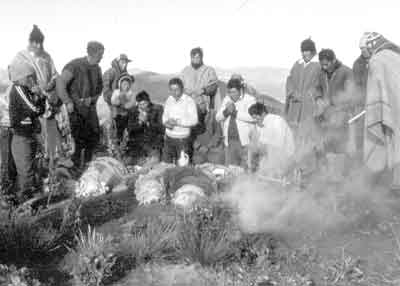
A ceremonial sacrifice of sheep is offered on a sacred hilltop in the altiplano to honour Mother Earth and perpetuate her bounty
- P.F. BROWN
Peru's social, economic and political fluctuations since 1980 have been among the most extreme in the world (Dietz, 1998). Since 1984, more villagers have migrated from the countryside seeking jobs or refuge from the threat of Shining Path terrorism. The economic process of out-migration became a flood of refugees fleeing from the war-torn countryside, with the displaced numbering at least 150 000 by 1986 (Mayer, 1994). Economic fluctuations were rife in Peru in the 1980s and 1990s. Some economic respite was felt in the countryside in the late 1980s and again in the early 1990s after the capture of the Shining Path leader, but with the centralization of the Peruvian Government in the 1990s the highland people were once again marginalized (Klarén, 2000). The subsistence farmers of the altiplano are fortunate to be able to fall back on their land for basic food production, but communities also need out-migration and circular labour migration to maintain their stable human/resource relationship. The success of wage labour migration fluctuates with the fortunes of Peru.
The world beyond the village and its surrounding countryside is not as reliable, equitable or predictable as the village. Like natural disasters that unexpectedly deliver punishments from God, the wages, transportation and housing of the modern world appear capricious. If the disappearance of reciprocal labour continues, will the values of balance among people and between humans and their environment continue long into the twenty-first century? Will a trend away from reciprocity and balance in social relationships also signal less stewardship of the fragile mountain ecosystem that has supported these people for centuries? Planners of economic development schemes must be alert to the risk of undermining these traditional values if sustainable agriculture is to continue in these regions.
Bibliography
Arguedas, J.M. 1966. A call to some doctors [in Quechua]. English translation printed in Cultural Survival Quarterly, 1986, 10(3): 10.
Brown, J.K. 1970. A note on the division of labour by sex. American Anthropologist, 72: 1073-1078.
Brown, P.F. 1987. Population growth and the disappearance of reciprocal labour in a highland Peruvian community. Research in Economic Anthropology, 8: 225-245.
Dietz, H.A. 1998. Peru since 1990. Latin American Research Review, 33(2): 197-206.
Gade, D.W. 1999. Nature and culture in the Andes. Madison, Wisconsin, USA, University of Wisconsin Press.
Goldstein, M.C. 1987. When brothers share a wife. Natural History, 96(3).
Grôtzbach, E. & Stadel, C. 1997. Mountain peoples and cultures. In B. Messerli & J.D. Ives, eds. Mountains of the world: a global priority. New York and Carnforth, UK, Parthenon Publishing Group.
Hewitt, F. 1997. Women of the high pastures - Karakorum-Himalaya. In B. Messerli & J.D. Ives, eds. Mountains of the world: a global priority. New York and Carnforth, UK, Parthenon Publishing Group.
Ives, J. 1997. Comparative inequalities - mountain communities and mountain families. In B. Messerli & J.D. Ives, eds. Mountains of the world: a global priority. New York and Carnforth, UK, Parthenon Publishing Group.
Klarén, P.F. 2000. Peru: society and nationhood in the Andes. New York, USA, Oxford University Press.
Leatherman, T., Luerssen, J.S., Markowitz, L. & Thomas, R.B. 1986. Illness and political economy - the Andean dialectic. Cultural Survival Quarterly, 10(3): 19-21.
Martinez, H. 1961. Las migraciones altiplánicas y la colonización del Tambopata. Plan nacional de integración de la población aborigen. Serie Monográfica No. 1. Lima, Peru, Ministerio de Trabajo y Seguridad Social, Dirección Nacional de Asuntos Indígenas.
Mayer, E. 1994. Patterns of violence in the Andes. Latin American Research Review 29(2): 141-171.
Meybeck, M., Green, P. & Vörösmarty, C.J. 2001. A new typology for mountains and other relief classes: an application to global continental water resources and population distribution. Mountain Research and Development, 21(1): 34-45.
Mitchell, W.L. 1993 Lightning sickness. Natural History, 102(11): 6-8.
Mitchell, W.P. 1991. Peasants on the edge: crop, cult, and crisis in the Andes. Austin, Texas, USA, University of Texas Press.
Murra, J.V. 1968. An Aymara kingdom in 1567. Ethnohistory, 15: 115-151.
Murra, J.V. 1975. El control vertical de un máximo de pisos ecológicas en la economía de las sociedades andinas. In J. Murra, ed. Formaciones económicas y políticas del mundo andino. Lima, Peru, Instituto de Estudios Peruanos.
Murra, J.V. 1986. José María Arguedas: introduction to a Quechua poet. Cultural Survival Quarterly, 10(3): 8-9.
Neustadtl, S. 1986. Mountain people - a searcher's guide. Cultural Survival Quarterly, 10(3): 1-7.
Ortner, S. 1978. Sherpas through their rituals. New York, USA, Cambridge University Press.
Orlove, B. 1977. Against a definition of peasantries: agrarian production in Andean Peru. In R. Halperin & J. Dow, eds. Peasant livelihood: studies in economic anthropology and cultural ecology. New York, USA, St Martin's Press.
Richardson, J.B. 1994. People of the Andes. Washington, DC, USA, Smithsonian Books.
Straughan, B. 1991. The secrets of ancient Tiwanaku. Smithsonian Magazine, 21(11): 38-47.
Winterhalder, B., Larsen, R. & Thomas, R.B. 1974. Dung as an essential resource in a highland Peruvian community. Human Ecology, 2: 89-104.